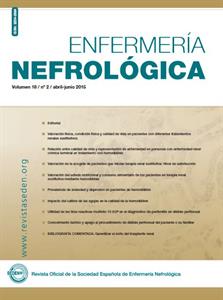Contenido del artículo principal
Resumen
Introducción: La malnutrición proteico-energética es un hecho frecuente entre los pacientes en tratamiento sustitutivo renal con hemodiálisis y a ello contribuye, además de la propia técnica dialítica, la dieta inadecuada.
Objetivos: Valorar la evolución del estado nutricional y la ingesta alimentaria de los pacientes de 3 unidades de hemodiálisis extrahospitalaria, tras una intervención enfermera educativa.
Pacientes y métodos: Hemos realizado un estudio transversal en 66 pacientes de 3 unidades extrahospitalarias (44 hombres y 23 mujeres) con dosis de diálisis medida por KT/V > 1,3 .Se hizo una determinación del estado nutricional por métodos convencionales y del consumo alimentario mediante encuesta dietética, determinándose mediante soporte informático el índice de alimentación saludable, identificando los déficits y/o excesos de nutrientes en cada paciente.
Se llevaron a cabo intervenciones educativas personalizadas dirigidas a corregir los excesos o déficits de nutrientes detectados en los pacientes, y se volvieron a hacer las mismas valoraciones a los seis meses.
Resultados: La prevalencia de desnutrición es leve en el 41% de hombres y 43% de las mujeres y moderada en el 34% de los hombres y 21% de las mujeres. El índice de alimentación saludable era inadecuado en el 37,31% de los pacientes en el análisis basal y postintervención educativa paso al 18,8%.
La ingesta media energética es elevada (1398.86 Kcal/paciente/día) con alto consumo de colesterol y déficit de aminoácidos. Se detectó un alto consumo de hidratos de carbono simples (> 20%) y un elevado uso de proteínas de origen animal. El contenido mineral y vitamínico de la dieta es muy deficiente, destacando el bajo consumo de Vitamina D (1.45±2.55 ng) y elevado de fósforo (1052.28±356.23 m/día).
Conclusion: Tras una intervención educativa sobre nuestros pacientes, corrigiendo hábitos dietéticos no saludables, hemos conseguido mejorar su estado nutricional, reduciendo la prevalencia de desnutrición en nuestras unidades.
Objetivos: Valorar la evolución del estado nutricional y la ingesta alimentaria de los pacientes de 3 unidades de hemodiálisis extrahospitalaria, tras una intervención enfermera educativa.
Pacientes y métodos: Hemos realizado un estudio transversal en 66 pacientes de 3 unidades extrahospitalarias (44 hombres y 23 mujeres) con dosis de diálisis medida por KT/V > 1,3 .Se hizo una determinación del estado nutricional por métodos convencionales y del consumo alimentario mediante encuesta dietética, determinándose mediante soporte informático el índice de alimentación saludable, identificando los déficits y/o excesos de nutrientes en cada paciente.
Se llevaron a cabo intervenciones educativas personalizadas dirigidas a corregir los excesos o déficits de nutrientes detectados en los pacientes, y se volvieron a hacer las mismas valoraciones a los seis meses.
Resultados: La prevalencia de desnutrición es leve en el 41% de hombres y 43% de las mujeres y moderada en el 34% de los hombres y 21% de las mujeres. El índice de alimentación saludable era inadecuado en el 37,31% de los pacientes en el análisis basal y postintervención educativa paso al 18,8%.
La ingesta media energética es elevada (1398.86 Kcal/paciente/día) con alto consumo de colesterol y déficit de aminoácidos. Se detectó un alto consumo de hidratos de carbono simples (> 20%) y un elevado uso de proteínas de origen animal. El contenido mineral y vitamínico de la dieta es muy deficiente, destacando el bajo consumo de Vitamina D (1.45±2.55 ng) y elevado de fósforo (1052.28±356.23 m/día).
Conclusion: Tras una intervención educativa sobre nuestros pacientes, corrigiendo hábitos dietéticos no saludables, hemos conseguido mejorar su estado nutricional, reduciendo la prevalencia de desnutrición en nuestras unidades.
Palabras clave
valoración nutricional; hemodiálisis; encuesta alimentaria.
Detalles del artículo
Licencia
Aviso de derechos de autor/a
© Los autores ceden de forma no exclusiva los derechos de explotación de los trabajos publicados y consiente en que su uso y distribución se realice con la Licencia Creative Commons Atribución - No comercial 4.0 Internacional (CC BY-NC 4.0). Puede consultar desde aquí la versión informativa y el texto legal de la licencia. Esta circunstancia ha de hacerse constar expresamente de esta forma cuando sea necesario.
Cómo citar
1.
Pereira Feijoo C, Queija Martínez L, Blanco Pérez A, Rivera Egusquiza IA, Martínez Maestro VE, Prada Monterrubio Z. Valoración del estado nutricional y consumo alimentario de los pacientes en terapia renal sustitutiva mediante hemodiálisis. Enferm Nefrol [Internet]. 2015 [consultado 20 Dic 2025];18(2):[aprox. 9 p.]. Disponible en: https://www.enfermerianefrologica.com/revista/article/view/3990




